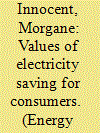| Srl | Item |
| 1 |
ID:
103396


|
|
|
|
|
| Publication |
2011.
|
| Summary/Abstract |
The Digital Television (DTV) Converter Box Coupon Program was administered by the U.S. government to subsidize purchases of digital-to-analog converter boxes, with up to two $40 coupons for each eligible household. In order to qualify as Coupon Eligible Converter Boxes (CECBs), these devices had to meet a number of minimum performance specifications, including energy efficiency standards. The Energy Star Program also established voluntary energy efficiency specifications that are more stringent than the CECB requirements. In this study, we measured the power and energy consumptions for a sample of 12 CECBs (including 6 Energy Star labeled models) in-use in homes and estimated aggregate energy savings produced by the energy efficiency policies. Based on the 35 million coupons redeemed through the end of the program, our analysis indicates that between 2500 and 3700 GWh per year are saved as a result of the energy efficiency policies implemented on digital-to-analog converter boxes. The energy savings generated are equivalent to the annual electricity use of 280,000 average US homes.
|
|
|
|
|
|
|
|
|
|
|
|
|
|
|
|
| 2 |
ID:
124681


|
|
|
|
|
| Publication |
2013.
|
| Summary/Abstract |
In this paper we evaluate two approaches for estimating CO2 emission reduction from electricity savings: one based on average CO2 intensities of electricity generation and another that relies on marginal CO2 intensities.
It is found that the average CO2 intensity approach has a significant shortcoming when it comes to scenario-based approaches for CO2 emission reduction. This shortcoming lies in the chicken-egg problem created, where larger future electricity savings are actually big enough to change the CO2 intensity in such a way that it cannot be used anymore to estimate the CO2 emission reduction. We show that in these cases the marginal approach is preferred. To correctly apply this approach, it is important to determine the CO2 intensity of the future power mix which will not be built in order to avoid under or overestimation of the CO2 savings calculated. We propose a seven-step approach which can be used in scenario-based potential studies as guidance for estimating the CO2 emission reductions from not only electricity savings but also renewable electricity and mitigation options that consume electricity such as electric cars and heat pumps. Using our approach would avoid a disconnection of the CO2 reduction potential with the underlying reference scenario.
|
|
|
|
|
|
|
|
|
|
|
|
|
|
|
|
| 3 |
ID:
171361


|
|
|
|
|
| Summary/Abstract |
Adoption of higher energy efficiency for electrical appliances by consumers in Sub-Saharan Africa (SSA) is challenged with a number of barriers despite its long term energy savings and economic benefits. Inefficient electrical appliances continue to flood the markets of most SSA countries with just a few of the counties having resolute energy efficiency programs with established energy efficiency standards and labels. This paper examines the barriers to energy efficiency in SSA, with a case study on how Ghana was able to overcome these barriers by using high levels of stakeholder engagement to develop and implement its energy efficiency standards and labels for electrical appliances.
Analysis from this study reveals that the Ghana policy development process is consistent with a quadruple helix model of policy and marketplace innovation. The quadruple-helix analytical framework identifies four key sectors of society: government, academia, industry and public/media that drive energy efficiency knowledge and innovations. The resulting barrier removal and institutional transformations enabled by the quadruple-helix dynamics have laid the foundation for a dramatic expansion of Ghanaian energy efficiency policy-making. New energy efficiency policies in Ghana are expected to revise or implement new efficiency standards on a total of 20 product categories by 2022.
|
|
|
|
|
|
|
|
|
|
|
|
|
|
|
|
| 4 |
ID:
162300


|
|
|
|
|
| Summary/Abstract |
This study aims at understanding the perceived value to consumers of practicing electricity saving. Based on an exploratory qualitative investigation and on two quantitative surveys, our study seeks to identify the values of electricity saving and model their relation with the intensity of electricity-saving behaviours. The results point to seven components of positive or negative assessments linked to the practice of electricity saving. These can be described in terms of environmental and citizen aspects, household management, feelings of well-being, secondary benefits, daily efforts, social consequences and lack of knowledge. Our results suggest that the main value lever of electricity-saving for consumers is more closely linked to well-being rather than environmental or money-saving concerns. These findings lead us to formulate new recommendations for public authorities to support their efforts in reducing residential electricity consumption.
|
|
|
|
|
|
|
|
|
|
|
|
|
|
|
|